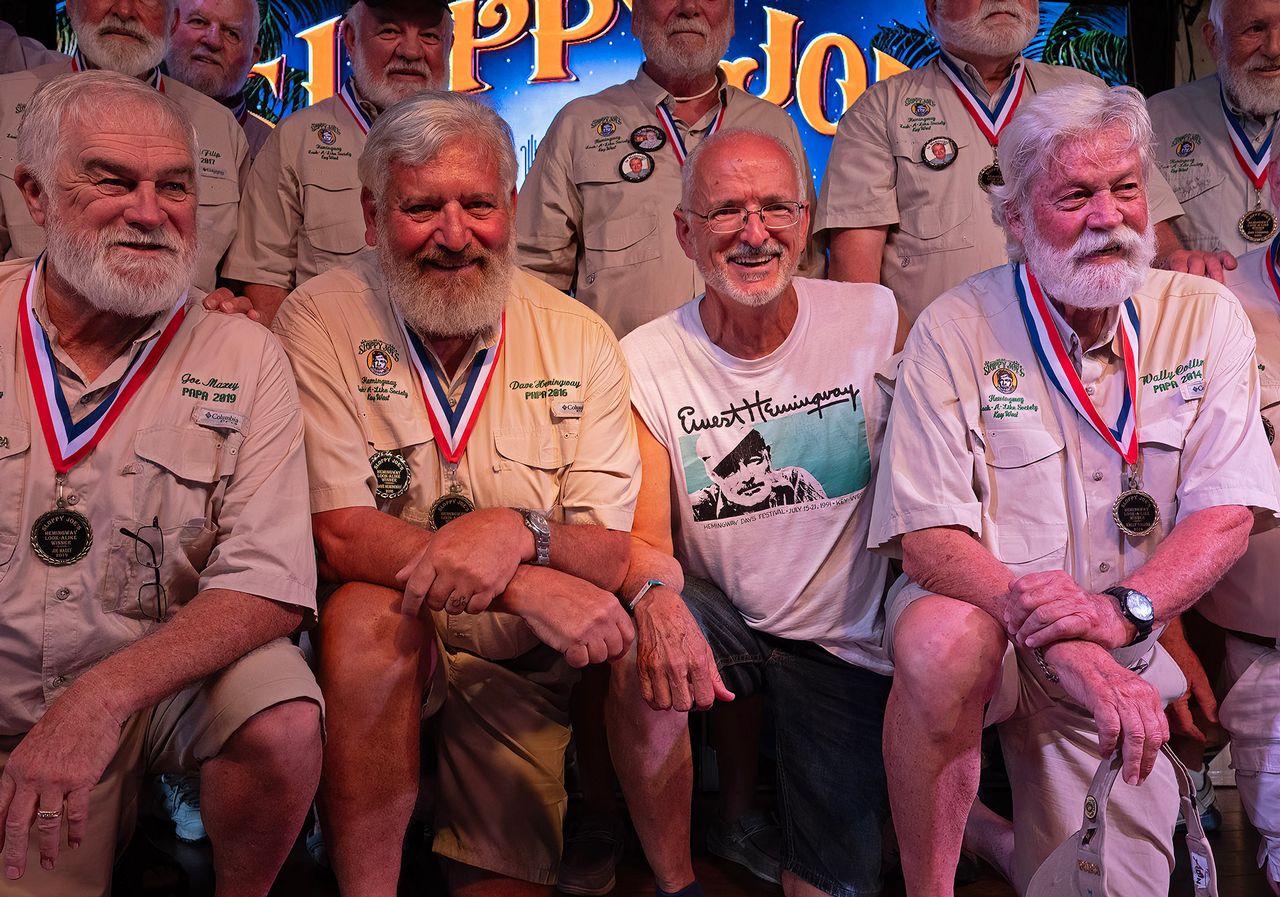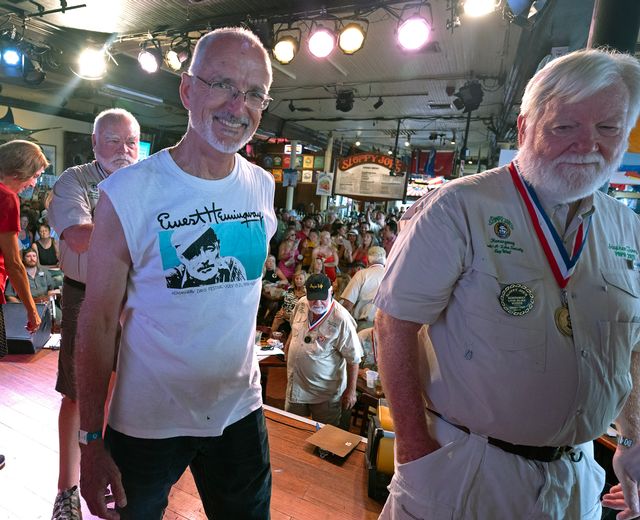Hemingway Days Founder Michael Whalton Recalls Festival’s Origin
When former Key West resident Michael Whalton conceived Hemingway Days more than 40 years ago, he couldn’t possibly foresee it would become a continuing, internationally recognized celebration of the island’s best-known inhabitant.
At the time, he was a day manager at Sloppy Joe’s Bar, famed as a hangout of Ernest Hemingway’s when he lived in 1930s Key West.
Whalton directed the festival for 16 years before moving to West Virginia in the mid-1990s. Under his leadership, Hemingway Days grew from a local event to a widely acclaimed salute to the author’s literary mastery, vigorous lifestyle and enduring affection for Key West and its people — including Sloppy Joe’s owner Joe “Josie” Russell.
In July 2023, Whalton traveled back to Key West to experience Hemingway Days for the first time since his departure. During his visit, he reflected on the iconic festival’s origin, growth and continued significance.
Q: How did you get the idea for Hemingway Days?
Michael Whalton: In December of 1980, I read an article about the Bad Hemingway Contest held in Los Angeles. It was a writing competition to parody Hemingway's writing. And because Sloppy Joe’s had such a history with Hemingway and Josie Russell, it seemed like we could do something to honor Hemingway here in Key West.
Q: So it developed from there?
MW: Hemingway’s birthday was July 21, and I thought we might create a festival around that. I figured it would be a good way to bring business in. Summer was a slow time back in 1981. We thought we would do a short story competition, a Look-Alike Contest and a street fair. And then we decided to do a beer-drinking contest as well.
Q: How did the Hemingway family get involved?
MW: About a month before the festival, one of the bartenders told me a guy who said he was Ernest Hemingway's brother wanted to talk to me. So I came out and Leicester Hemingway, Ernest’s 18-years-younger brother, was here. He had just finished doing a billfish tournament in Key West, and he wondered if he could enter the Look-Alike Contest.
Q: What did you say?
MW: I said, “Mr. Hemingway, I'm sorry. Why don't you be the judge for the Look-Alike Contest?” So Les became the judge of the first Hemingway Look-Alike Contest. And through him, I met his wife, Doris, and their daughters. I also met Lorian Hemingway and she agreed to be the judge of the short story contest.
Q: Was the first Look-Alike Contest successful?
MW: The week before the festival, we had nobody sign up for the Look-Alike Contest — so I called everybody I knew in Key West who had a beard and begged them to come down to the bar. They all showed up, and about 20 other gentlemen who had beards came in.
We ended up with, I think, 36 contestants the first year. The winner was Tom Feeney, an officer in the Coast Guard — very nice gentleman. When we chose Tom as the winner, Les Hemingway said, “There's no second place. Everybody gets to think that they were the runner-up.”
Q: How did the other events go?
MW: The beer-drinking contest was less successful. The fellow who won actually ended up being discovered the next morning naked in a neighbor's yard, so we canceled that event. But over the next few years, we added several new events, including a party at the Hemingway Home & Museum and the billfish tournament.
Q: Did you have prizes for the early Look-Alike Contest?
MW: When the look-alikes won, they became judges for the next year. But in those early years, we didn't have a lot of exciting prizes for them. We had a case of Fundador Brandy and a front-end alignment from Boa’s Tire and Auto, which always got a laugh from the audience. I'm not sure if any of the look-alikes ever took advantage of that.
Q: What do you think Hemingway means or meant to Key West?
MW: When Hemingway lived in Key West throughout the 1930s, he was a prominent figure on the island despite trying to keep a low profile. And he attracted many other writers who became instrumental in the success of the arts community here.
So it was a wonderful thing to be able to pay tribute to Hemingway, and at the same time, we were able to create a writers workshop and conference. We had John Updike, James Dickey, Russell Banks and Peter Matthiessen come here and receive the festival’s (then) Conch Republic Prize for Literature.
Q: But after 16 years, you turned the coordination of Hemingway Days over to Sloppy Joe’s and others?
MW: It's been some 25 years since I was at the last Hemingway Days festival that I coordinated. Shortly after Doris Hemingway passed in 1996, Ernest Hemingway’s sons decided they wanted to take control of the festival and their New York City licensing company contacted me with a list of demands. Rather than take on a fight, I decided to hand over the Look-Alike Contest to Sloppy Joe’s and everything else to the Hemingway Home & Museum.
Ultimately, it may have been one of the best decisions I ever made, since the Hemingway Look-Alike Society was officially born in 1997 and the look-alikes began fundraising for scholarships that year. Although the Hemingway Home & Museum stopped coordinating the festival after 1998, Sloppy Joe’s and other businesses stepped up and created a number of events that continue to complement the Look-Alike Contest.
Q: When you returned for Hemingway Days this year, how did you feel?
MW: It was a little overwhelming because I didn't expect to see the growth that there has been to the Look-Alike Society. The fact that it is so well-organized and that the previous winners of the Look-Alike Contest have taken this to heart, and created this buzz around the whole festival, is truly remarkable. And every year they raise hundreds of thousands of dollars for scholarships to nursing and writing programs at the College of the Florida Keys and to seniors graduating from Key West High.
Q: When you started Hemingway Days in 1981, did you ever imagine it would still be flourishing in 2023?
MW: It's pretty amazing how much it's grown and how successful it's become. The look-alikes do a great job of bringing enthusiasm and excitement into the island, and the fact that they raise so much money for scholarships every year is delightful. Forty-two years later, this festival is bigger and better than ever.
Under Whalton's leadership, Hemingway Days grew from a local event to a widely acclaimed salute to the author’s literary mastery, vigorous lifestyle and enduring affection for Key West and its people. Photo: Andy Newman
In July 2023, Whalton traveled back to Key West to experience Hemingway Days for the first time since his departure 16 years prior. Photo: Andy Newman
Reflecting back, Whalton is amazed at the growth and success of the festival, especially the Look-Alike Contest and its dedication to supporting higher education for Florida Keys students. Photo: Andy Newman



